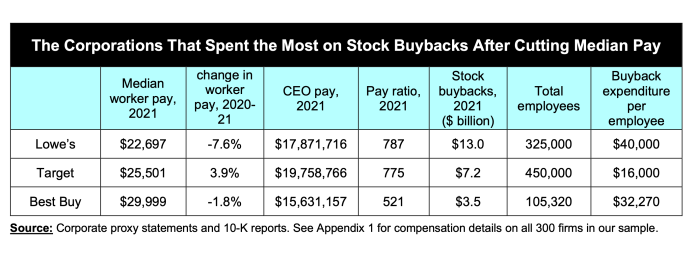Executive Excess 2022
The CEOs at America’s largest low-wage employers are grabbing huge raises while workers and consumers struggle with rising costs.
Sarah Anderson | Sam Pizzigati | Brian Wakamo
Introduction
Throughout the pandemic, essential workers have labored heroically. But while workers risked their lives, bosses have reaped the rewards.
In our last report, we found that more than half of our nation’s 100 largest low-wage employers changed their own rules to ensure huge payouts for CEOs in 2020 — while workers lost wages, jobs, and even their lives. On average, the CEOs at these rule-rigging firms pocketed 29 percent raises while their median worker pay fell by 2 percent.
This 28th edition of Executive Excess extends the story.
We found that last year, with the economy in recovery mode, corporate leaders shifted to new CEO pay-inflating tactics. Many low-wage corporations spent record sums on stock buybacks. Others high-handedly used the COVID-19 crisis as a cover for jacking up prices to consumers.
Both maneuvers made it easier for CEOs to score massive bonuses. Wages at many of these companies, meanwhile, failed to keep up with inflation — and some actually declined. Worst of all, taxpayers are directly subsidizing these outrages through federal contracts.
This executive excess has Americans across the political spectrum fed up. But as we’ll explore, there are solutions.

Key Findings
We examined compensation over the past year at the 300 publicly held U.S. corporations that had the lowest median wages in 2020.
- The CEO-worker pay gap at low-wage corporations grew even wider in 2021.
- At 106 of the 300 firms we studied, median worker pay did not keep pace with inflation.
- The average gap between CEO and median worker pay in our sample jumped to 670 to 1, up from 604 to 1 in 2020. Forty-nine firms had ratios above 1,000 to 1.
- CEO pay at these 300 firms increased by $2.5 million to an average of $10.6 million, while median worker pay increased by only $3,556 to an average of $23,968.
- Two-thirds of low-wage firms that cut worker pay in 2021 spent billions on stock buybacks .
- Of the 106 companies in our sample where median worker pay did not keep pace with inflation, 67 spent money on stock buybacks, a maneuver that inflates executive stock-based pay. These repurchases totaled $43.7 billion.
- With the $13 billion Lowes alone spent on share repurchases, the company could have given each of its 325,000 employees a $40,000 raise. Instead, its median pay fell 7.6 percent to $22,697.
- Taxpayer dollars are fueling corporations with extreme CEO-worker pay gaps.
- Of the 300 companies in our sample, 40 percent received federal contracts between October 1, 2019 and May 1, 2022. The combined value of these contracts was $37.2 billion.
- At these low-wage contractors, the average CEO-worker pay ratio hit 571 to 1 in 2021. Only 6 of the 119 contractors had pay gaps of less than 100 to 1.
- Policy solutions for runaway CEO pay do exist — and enjoy broad support.
- Some 62 percent of Republicans and 75 percent of Democrats support an outright cap on CEO pay relative to worker pay.
- While a hard cap is unlikely, other CEO pay reforms have also gained traction in recent years. These reforms focus on three key areas:
- CEO pay ratio incentives for federal contractors
- Excessive CEO pay taxes
- Stock buyback restrictions and taxes
By contrast, CEO pay last year soared 31 percent to an average $10.6 million at these 300 low-wage firms. This stunning increase drove the average gap between CEO and median worker pay at these companies to 670 to 1 — up from 604 to 1 in 2020.
At 49 of the 300 firms, pay ratios topped 1,000 to 1.

- Amazon CEO Andy Jassy raked in $212.7 million last year, which amounts to 6,474 times the $32,855 take-home of Amazon’s typical worker. The company has spent millions fighting union campaigns at several of its warehouses.
- Estee Lauder CEO Fabrizio Freda enjoyed a 258 percent pay increase in 2021, raising his annual compensation to $66.0 million — 1,965 times more than the firm’s $33,586 typical employee pay. Over the past year, Estee Lauder slashed its global workforce from 75,000 to 62,000. None of the firm’s U.S. workers have union representation.
- Penn National Gaming CEO Jay Snowden’s $65.9 million payout equaled 1,942 times the company’s $33,930 median pay. Less than 20 percent of Penn’s staff is unionized.
Our buyback research directed special attention to the 106 firms where median worker pay did not keep pace with inflation in 2021. Some 67 of these firms — two-thirds of them — spent a total of $43.7 billion buying back their own shares.

1. Lowe’s
The median Lowe’s worker’s compensation fell by 7.6 percent to $22,697 in 2021. The same year, CEO Marvin Ellison spent more than $13 billion on stock buybacks. If those funds had instead been divided among the company’s 325,000 employees, Lowe’s could have given each worker a $40,000 raise.
Ellison raked in $17.9 million last year, 787 times as much as the firm’s median pay.
2. Target
Target blew $7.2 billion on buybacks in 2021, enough to give all 450,000 Target employees a $16,000 raise. CEO Brian Cornell made $19.8 million last year, 775 times more than Target’s $25,501 median pay.
In May 2022, Target employees at one Virginia store petitioned for a union election, and union drives are reportedly also taking root in several other Target stores.
3. Best Buy
Best Buy spent $3.5 billion repurchasing company stock, a sum that could have covered a $32,270 raise for each of Best Buy’s 105,320 employees. Instead, median pay at Best Buy dropped 1.8 percent to $29,999.
CEO Corie Barry, meanwhile, enjoyed a 30 percent raise to $15.6 million, 521 times her typical worker’s pay. Her 2021 haul included a $4.7 million cash bonus after she laid off 5,000 employees, most of them full-time workers.
The latest Best Buy annual report lists unionization among various potential risks that could “impair the viability of our operating model.”
Of the 300 companies in our sample, 119 — 40 percent — received federal contracts between October 1, 2019 and May 1, 2022. These contracts totaled $37.2 billion.
At these low-wage contractors, the average CEO-worker pay ratio sat at 571 to 1 in 2021. Only 6 of the 119 firms, just 5 percent, had pay gaps of less than 100 to 1. CEO pay among these 119 contractors last year averaged $11.8 million.

1. Maximus
Maximus has held $12.3 billion in federal contracts over recent years. The company’s contracts include deals to service federal student loans and operate Obamacare and Medicare call centers. In fiscal year 2021, federal contracts made up 45 percent of Maximus total revenue.
Half of the 49,800 Maximus employees earned less than $38,059 in 2021.
By contrast, Maximus CEO Bruce Caswell’s 2021 compensation totaled $7.9 million, 208 times the firm’s median pay — and 36 times the salary of the top officials at the government agencies responsible for the company’s largest contracts.
In March and again in May 2022, workers at Maximus call centers in Mississippi and Louisiana, a largely Black workforce, staged walkouts demanding higher pay, paid sick leave, and the opportunity to unionize without retaliation.
2. Amazon
Amazon has reported $10.3 billion in recent federal contracts, most of it to provide web services for the National Security Agency. The company reportedly also received a lucrative share of a multi-billion-dollar CIA contract for cloud services. The details and exact value of this contract continue to be classified.
Amazon’s new CEO raked in compensation worth $212.7 million last year, 6,474 times the company’s median pay and 961 times the salary for the U.S. secretary of defense.
3. TE Connectivity
TE Connectivity has landed $3.3 billion in recent federal contracts for manufacturing electronic sensors and connectors, partly under direct contract with the Defense Department and partly as a subcontractor.
CEO Terrence Curtin enjoyed a 39 percent 2021 pay increase to $14.7 million — 589 times the $24,975 its median worker earned. Under Curtin’s leadership, TE Connectivity has expanded its global workforce while cutting U.S. jobs.
1. CEO pay ratio incentives for federal contractors.
President Biden does not need to wait for Congress. His administration could use executive action to give corporations with narrower pay ratios preferential treatment in government contracting.
Long-established federal programs already offer a leg up in contracting to certain businesses, such as small firms owned by women, disabled veterans, or minorities. Using public procurement to address extreme disparities within large corporations would be a step towards the same general objective.
The Patriotic Corporations Act could serve as a model for executive action. This bill would grant preferential treatment in contracting to firms with pay ratios of 100 to 1 or less, among other benchmarks. The Congressional Progressive Caucus has called on Biden to introduce such conditions on contractors through executive action.
2. Excessive CEO pay taxes.
In the Build Back Better negotiations, Senate Finance Committee Chair Ron Wyden floated the idea of an excise tax on corporations with big gaps between CEO and worker pay. His proposal was loosely modeled on the Tax Excessive CEO Pay Act.
Under this bill, the wider a company’s gap between CEO and median worker pay, the higher their federal corporate tax rate. The highest penalty would apply to companies that pay top executives over 500 times worker pay. Companies with pay gaps of less than 50 to 1 would not owe an extra dime.
Rep. Mark DeSaulnier’s CEO Accountability and Responsibility Act would impose similar tax penalties for large pay ratios.
The Tax Excessive CEO Pay Act would raise an estimated $150 billion over 10 years. Tax penalties on companies with wide CEO-worker pay gaps are already raising revenue in San Francisco and Portland, Oregon.
3. Stock buyback taxes and restrictions.
Buybacks were largely illegal before 1982, and several bills have been introduced to reinstate that ban.
Last September, Senators Wyden and Sherrod Brown introduced another approach through the Stock Buyback Accountability Act. This bill would impose a 2 percent excise tax on the amount spent by a company on buying back its own stock, generating an estimated $124 billion over 10 years.
President Biden supported a buybacks tax as a revenue source for the Build Back Better bill and included such a tax in his latest budget proposal.
In addition, Biden proposed new rules that would ban top executives from selling their personal stock for a multi-year period after a buyback. This aims to prevent CEOs from timing share repurchases to cash in personally on a short-term price pop they themselves artificially created.
Instead of waiting for Congress, the president could take action by imposing such a ban on federal contractors.
